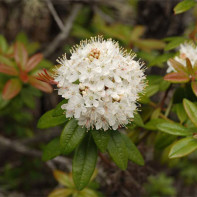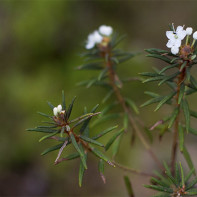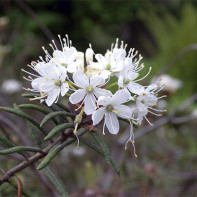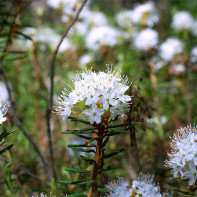Ledum marsh: medicinal properties and contraindications
Ledum is a perennial plant that belongs to the Heather family. In another way, it can be called a puzzle, swamp or marsh stupor. This is a fairly beautiful plant that attracts with its unusual smell. This article describes in more detail about marsh rosemary, its properties and mission in human life.
- Chemical composition
- How it looks and where it grows
- Kinds
- Collection and storage
- The healing properties of marsh rosemary
- For women
- For men
- During pregnancy
- For kids
- Ledum marsh in folk medicine
- Cough infusion
- Broth of marsh ledum with coltsfoot
- Ledum tea with nettle cough
- With tuberculosis
- When rhinitis
- For diuretic effect
- For blood circulation
- As an antibacterial drug
- Widely applicable Ledum infusion
- Joint disease ointment
- Types of medicinal compounds with ledum
- Infusion
- Tincture
- Decoction
- Tea
- Ointment
- Pharmaceutical preparations with Ledum
- Ledin
- Fitopril
- Ointment Ledum
- Ledum oil: properties and application
- Application in cosmetology
- The use of wild rosemary in everyday life
- Contraindications
Chemical composition
Essential oils, which are found in almost all parts of the plant except the root, give a rather specific smell to rosemary. The main component, which is located in Ledum, is ice. It is it that is widely applicable in drugs.

Almost 70% is occupied by special alcohols, which are used to obtain components such as cimol, guaiazulene and geranyl acetate. They have a pungent smell and a bitter taste. They are often used as part of expectorant medicines.
Most of the essential oils are found in the leaves of marsh ledum. For drugs, it is better to collect the leaves of a young plant. The plant also contains other components, such as:
- Arbutin. Often used for such an ailment as staphylococcus. Well inhibits the growth of pathogenic flora.
- Flavonoids. They have a positive effect on the circulatory system, are used to stop bleeding.
- Neomyrtillin. Used in the fight against diabetes, has an insulin-like property.
Also, the chemical composition of Ledum may vary slightly depending on the geographical location of the plant.
In addition to these substances, marsh rosemary contains a huge amount of vitamins, minerals and amino acids. It is important to know that the younger the plant, the more nutrients it contains.
How it looks and where it grows
Ledum constantly has a green color, grows in the form of a shrub ranging in size from about 60 cm to 2 m. The roots often go deep underground - up to 50 cm. The leaves are slightly raised, their length can reach 5 cm, width - within 2 cm. To the touch they are wrinkled, rather dense. Shoots have a brownish tint.
Ledum is also the owner of beautiful white flowers, sometimes with a pinkish tinge, which in diameter can reach 1 cm. The pungent smell of flowers spreads over a long distance. The flowers are collected in a kind of bunches, you can say small bouquets, about 10-15 pieces each. Ledum begins to bloom upon the onset of heat, in May or early July.
Already at the end of summer there is an intensive ripening of fruits. In appearance, the fruits have the appearance of a multi-seeded berry of a small size, about 0.5 centimeters. When fully ripened, the berry blooms, releasing many seeds.
Reproduction of rosemary can occur vegetatively, as well as with the help of seeds. It is important to know that it is a very poisonous plant, so you need to use it with caution in life.
Marsh rosemary can be found in many places in Russia, Ukraine, Belarus. It is especially common in Siberia and the East, most often growing on a marshy surface or in humid coniferous forests.
Kinds
In addition to the classic marsh ledum, there are several more species of this plant that are not so common.
- Greenlandic. The plant can be found in the vastness of North America. It looks like a shrub from 1 to 1.5 m in length with oblong green leaves. Flowering occurs in June and ends in July. The flowers are exclusively white in color, without any shades (in contrast to the classic marsh ledum, the flowers of which may have a pink tint). With the onset of frost, a repeated growth of shoots is observed.
- Creeping. A small shrub with a maximum size of only 30 cm. It grows very slowly in growth, about 2 cm per year. It grows most often in rocky areas or small mountains. You can meet in Chukotka, in North America or in the Far East. Flowering occurs at the end of May, and seed ripening only to the first autumn frosts.
- Large-leaved. A fairly tall shrub reaching a length of 1.5 m. Flowering begins in early May and ends in late summer. It has bright pink fairly large flowers with a pungent odor. It is found in coniferous areas in Korea and Japan, less commonly in Siberia and the Far East.
Collection and storage
An important rule when collecting Ledum is to protect yourself from the chemical effects of the plant, namely it is imperative to wear gloves. A respiratory mask can save you from a pungent smell. Harvesting marsh rosemary is best done in autumn, when ripening has already occurred. You need to collect only young plants that are no longer than 10 cm in length, since nutrients are found only in those shrubs that bloom the first year. For less damage, it is better to cut the shoots with a knife obliquely. For treatment, they usually collect leaves along with flowers and seeds, so the raw materials will be more rich in vitamins.
Collected rosemary needs to be dried. There are several ways to do this. For example, on the street, in the shade, so that the plant does not burn out much under the sun. In this case, drying will take 2-3 weeks. It can be dried in small bundles that need to be tied and suspended in a room with the lowest humidity. Also in the age of high technology, you can use the dryer for vegetables and fruits. This is the fastest way, since in a day the rosemary will be ready.
Keep away from food and other plants in a container with a tight lid. Since in dried form rosemary also has a pronounced pungent odor. You can use the plant in dried form for 2-3 years, but not more. Over a long period of storage, Ledum may lose its useful properties.
The healing properties of marsh rosemary
Marsh rosemary has many useful substances that are often applicable in the treatment of many diseases. In traditional medicine, this plant is famous for the effective treatment of tuberculosis, dysentery, asthma and whooping cough, and also lice and bugs are removed from the leaves with the help of powder.

Often rosemary is used in combination with other plants, such as coltsfoot, plantain. In this combination, malaria, cystitis and even fever are treated. By adding ledum to the ointment, you can help treat eczema.
In Tibet, rosemary is known as a warming plant. Often in severe frosts it is added to tea. It is important to know the exact dosage, as this is a poisonous plant. If you do not follow the rules for its use, you can cause serious harm to health and even life.
For women
Women often use decoction of marsh rosemary for various diseases of the genitourinary system. The plant fights well with such an unpleasant ailment as cystitis, providing a good anti-inflammatory effect. In gynecology, marsh rosemary is also widely used. It is used in inflammatory processes, decoction treat such an unpleasant disease as Trichomonas of the genital tract. The main thing is to consider the dosage and not harm even more. Therefore, alternative methods of treating cystitis in women with the help of ledum should be treated very carefully.
In addition, women use wild rosemary in everyday life. The pungent smell and toxic substances of the plant deter many insects. To preserve clothes from moths, you can put several branches of dried ledum next to the thing.
For men
Men often use Ledum in unforeseen situations when hunting or fishing. The leaves of the plant heal well recently received wounds, which often happens in hunters. In the forest, a person can attract various insects, including mosquitoes and other unpleasant midges. Swamp rosemary in this case is a strong deterrent for unwanted guests. You can preload several branches of dried grass in your pocket. If an unforeseen situation occurs, and the plants are not in your pocket, you can try to find it in the vicinity.
During pregnancy
The effect of this plant on the well-being of a pregnant woman has conflicting opinions. Some consider it completely safe for the future mother and child, while others strictly forbid the use of the plant. There is an opinion that even in ancient times, with the help of a decoction of leaves of rosemary, women got rid of an unplanned pregnancy. And, of course, a woman in a position is better to refrain from using ambiguous decoctions.
For kids
For children, Ledum is widely used in acute respiratory diseases. The medicinal properties of the plant have a pronounced positive effect on diseases of the respiratory system, asphyxiating cough, acute bronchitis and asthma.
Pediatricians recommend not using the plant for medicinal purposes for children under 14 years of age, but even in the pharmacy you can find expectorant preparations, which include marsh ledum. The use of certain drugs is allowed for children from 3 years. Of course, it is better not to use Ledum for children on their own, i.e. without a doctor’s prescription. This can cause the opposite effect and severe allergic reactions in the child.
Ledum marsh in folk medicine
Ledum is widely used in folk medicine. The range of medicinal properties of the plant is simply huge. Essential oils found in the plant can cause a positive effect for many ailments. Although scientists recommend using rosemary with great care, since it contains, in addition to nutrients, a poisonous icebreaker, this does not prevent the plant from being used for many diseases. Below are a few folk recipes using marsh rosemary.
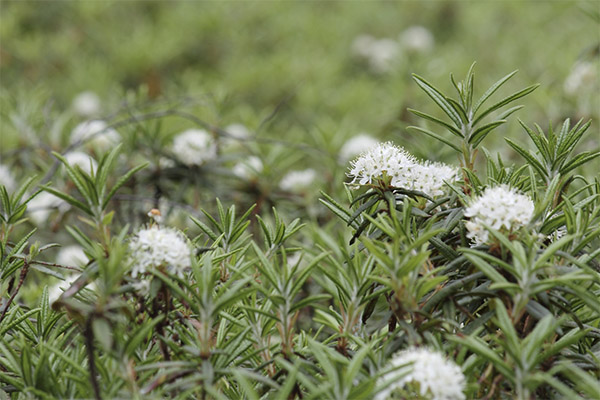
For starters, recipes for diseases of the respiratory system are presented. It is known that the use of ledum is widespread. It is used in the form of decoctions, inhalations, creams and as part of medicines that can be purchased at the pharmacy.
Cough infusion
Pour a tablespoon of pre-dried, chopped rosemary with a glass of boiling water and leave to brew for 40-60 minutes. After this, carefully strain the infusion so that the leaves do not accidentally enter the body when consumed. Then take a teaspoon, with an interval of at least 5 hours.
Broth of marsh ledum with coltsfoot
When coughing, for a better effect, you can add other useful plants, such as coltsfoot, to the decoction. It is necessary to bring 1 liter of water to a boil, after boiling, reduce the heat and add in equal proportions a spoonful of wild rosemary and coltsfoot. Allow to boil for 30-40 seconds and extinguish the fire. Let it brew for 5-10 minutes, strain well and divide into three equal parts. Take the broth in the morning, at lunch and in the evening, after eating.
Ledum tea with nettle cough
In addition to nettle and rosemary, in this broth there are several more components. Take a small branch of rosemary, a few sheets of nettle and a teaspoon of marsh rosemary. Pour the resulting mixture with 0.5 l of hot boiled water and let stand for half an hour. Take a quarter of a glass for one week.
With tuberculosis
With this disease, a cold infusion of rosemary is used.Pour a tablespoon of chopped dry rosemary with two glasses of cold water. Let it brew for a day. Infusion to use 3-4 times a day for 2 tablespoons.
When rhinitis
With a runny nose, it is used in the form of a special oil, which can be prepared independently as follows. A spoonful of dried chopped rosemary pour half a glass of vegetable oil. Insist for at least two weeks, so with an outbreak of acute respiratory viral infections, it is better to prepare this medicine in advance. When the oil is well infused, drip into the nose a few drops in each nostril 3 times a day. For a better effect, along with this, you can apply the classic decoction of Ledum.
For diuretic effect
In addition to all the medicinal properties, marsh ledum is used as a good diuretic for diseases of the kidneys or stones, as well as for the treatment of cystitis in women. It is necessary to brew a tablespoon of chopped rosemary in a glass of hot boiled water. Let it brew and strain well. Take a few tablespoons 3 times a day before meals.
For blood circulation
The plant is used as a prophylaxis and treatment of many diseases of the heart and blood vessels. Suffering from this ailment, we can recommend the following recipe. Boil for 15–20 minutes a tablespoon of rosemary, filled with 1 liter of water. Take a teaspoon several times a day.
As an antibacterial drug
The common cold oil mentioned earlier can also be used to heal severe wounds and burns. To do this, add a third of a decoction of classic rosemary and a third of ethyl alcohol to a liter container, you can use vodka. Let it brew in a cool place for at least 5 days. Lubricate the wounded parts of the body with a small amount of infusion.
Widely applicable Ledum infusion
This infusion is used for many ailments, such as eczema, rheumatism, flu and rheumatism. Take about 20-30 g of dried plant, pour 1 liter of boiled water. Put in the warmest place, you can well wrap a downy thing to keep warm. Let it brew for 5-6 hours. Take orally in the morning, at lunch and in the evening, ½ cup before meals for a week.
Joint disease ointment
It is necessary to take a container that can be heated in the future. Pour a glass of chopped dry rosemary into a container and add any fat that is at hand. It can be pork, bird or mutton. Put on fire for 3-5 minutes to melt the fat, then mix the resulting mixture. When cooling, refrigerate. Rub the obtained ointment into disturbing places 4-5 times a day.
Types of medicinal compounds with ledum
Ledum is widely applicable to many human diseases. Of course, he possesses the main healing properties in relation to everything related to respiratory diseases. But people found Ledum even more uses. A variety of medicinal compounds, ointments, creams, infusions are created from it.
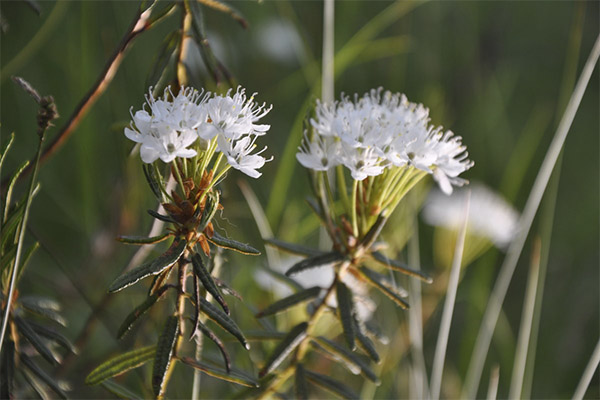
In the East, such a healing composition as honey on the flowers of Ledum is very common. People specifically grow this plant near the apiary. At the same time, such honey helps to fight many health problems. Since the plant itself contains poisonous components, honey must be taken in a certain dosage. If you abuse this delicacy, the result may be unpredictable. Honey rosemary has a pungent taste and smell.
With Ledum, there are many types of infusions that have healing properties.
Infusion
Water infusion is used as a diuretic, and also has a positive effect on the human nervous system. Different types of infusions based on ledum are used to treat asthma, various types of bronchitis, whooping cough, and also as a lotion for damaged or problem skin.
For infusion, which is taken orally, you need to brew about 10 g of dried rosemary and brew 0.5 l of boiled water. Insist for half an hour and strain well. Take a tablespoon 3-4 times a day.
There is a solution with a lower concentration. To do this, take a teaspoon of dried marsh rosemary, pour 1 liter of cold water and let it brew for a day. Such a solution can be taken not only for the treatment of any diseases, but also for prevention, for example, in nervous life situations for soothing purposes. You can take such an infusion in the morning and evening in half a glass.
For external use, infusion with ledum is done as follows. 3-4 tablespoons of dried rosemary pour 300 ml of hot boiled water. Let it brew for 5-6 hours. Infusion can rub various eczema, wipe wounds, and also use as compresses for any serious wounds.
Some doctors recommend for various diseases infusion of ledum, which causes a diaphoretic effect in the body. It can also be used for colds, in the absence of high body temperature, since this infusion has a warming effect on the body. You can prepare it as follows. Approximately 50 g of dry rosemary pour 1 liter of water and boil for 15-20 minutes. You need to take this type of infusion only in a warm, even hot form, in half a glass 2 times a day.
Tincture
With rheumatism, tincture of marsh rosemary is used. For it, you need 3-4 tablespoons of dry chopped rosemary, 0.5 l of alcohol, you can use vodka for lack of the first. The effect of this will not change. Let it brew in a warm, dark place for two to three days. Apply as rubbing 2 times a day.
Decoction
A special broth is used for serious diseases of the respiratory tract, such as whooping cough, asthma, acute bronchitis. Pour a tablespoon of dried rosemary with a glass of hot water, boil for several minutes, let it brew for half an hour. Filter well. Take a teaspoon 4-5 times a day.
If such a decoction is improved a little and vegetable oil is added to it one to one, various skin diseases can be treated by lubricating the affected parts of the body with this composition. It is especially relevant for various types of lichen.
Tea
The most common tea collection is taken for the prevention of colds, as well as for allergic bronchitis or asthma. For it, you will need several teaspoons of rosemary dried in advance, 5-6 dried nettle leaves. Composition pour 1 liter of boiled water and leave for several hours. Add the resulting collection to tea for 2-3 tablespoons.
Tea from dysentery can be taken as follows. Approximately 10 g of crushed marshmallow root, a tablespoon of dried wild rosemary pour 1 liter of boiling water and add - 3 teaspoons to tea.
To prevent such an unpleasant disease as obesity, you can add a special collection to tea. To do this, you need 20-30 g of motherwort, which can be purchased at the pharmacy or collected by yourself. Add a couple of tablespoons of dried rosemary and a tablespoon of horsetail. Boil the resulting mixture over low heat for half an hour. Let it brew, add a tablespoon to tea.
Ointment
There are a large number of ointments with ledum, which can be prepared independently at home. Consider some of the most common and effective.
- Ledum based scabies ointment has established itself as a sufficient effective medicine. It will take 200 g of dry rosemary, the root of white hellebore. Mix the plants with pork fat. Evaporate in a water bath for 2-3 hours. Lubricate damaged skin areas 3 times a day, as well as healthy for prevention.
- For joint diseases, the following ointment can be used. You need to take dried rosemary (3-4 tablespoons), boil, free the broth from the leaves and add vegetable oil one to one. Let it brew for a day. Lubricate painful parts of the body up to 5 times a day. In this case, you can notice relief after the first application.
Pharmaceutical preparations with Ledum
In pharmacies you can find a fairly large number of preparations based on ledum, which are presented in different forms and are used for various ailments. In pharmacy, literally all parts of wild rosemary are used. These are roots, branches, flowers and leaves, but escapes of rosemary are of special value in the production of medicines.
A sufficiently large range of medicinal properties of wild rosemary contributes to the fact that on the shelves you can find medicines based on this plant from almost all known diseases. This is for example:
- Means to help establish blood pressure.
- Infusion of rosemary leaves to combat bronchial asthma.
- Ledum essential oils fighting acute rhinitis.
- Teas that eliminate bowel disease.
- Numerous ointments that are used for diseases and damage to the skin.
Consider the most common pharmaceutical drugs that are most often found in pharmacies.
Ledin
The drug in the form of tablets is aimed at the treatment and prevention of diseases such as laryngitis, acute bronchitis, bronchial asthma. The composition contains the active substance sesquiterpene alcohol. The drug is recommended to take one tablet 3 times a day, for 7-10 days. Contraindications to this drug include the fact that it can be taken only from the age of 16, and Ledin can not be pregnant and during breastfeeding. If side effects such as allergic reactions, nausea or drowsiness occur, the drug should be discontinued. Sesquiterpene alcohol, which is obtained from marsh rosemary, has a strong expectorant and anti-inflammatory effect. Ledin has established himself on a very positive side and is one of the most purchased drugs for respiratory diseases.
Fitopril
A fairly new drug in the pharmaceutical industry, which is aimed at preventing stroke, and is also used for arrhythmias. Available in the form of a beta-blocker, which normalizes the functioning of the heart. The composition is predominantly herbal preparations, including the leaves of marsh ledum. Recommended for use 2 times a day, a tablespoon. Use should only be prescribed by a doctor. Ideally selected components in the composition help the work of the cardiovascular system of the human body.
Ointment Ledum
The drug is used for joint diseases, and also prevents insect bites. The tool removes puffiness well and is used for disinfection. Available in tubes of different volumes - from 5 to 25 mg. The composition of the drug contains only natural components, so it can be used by both adults and children from 3 years of age. It is not recommended for people who suffer from any form of allergic reaction. Apply the ointment in a thin layer to damaged areas of the body 5 times a day. Ledum is also recommended in a larger consistency for combating eczema, as a warming drug for severe coughing and treatment of various forms of gangrene.
In addition, in the pharmacy you can buy ready-made dried rosemary at a very attractive price.
Ledum oil: properties and application
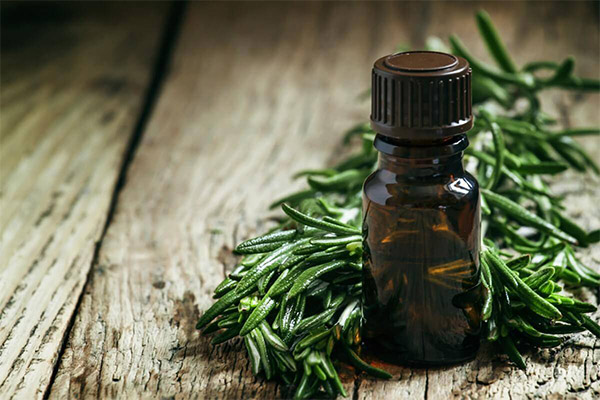
Ledum oil is widespread in both folk and conventional medicine. This explains a wide range of its properties.
- used as a good expectorant;
- fatally affects the tuberculosis shelf in the human body;
- quickly removes inflammatory processes of the skin, including those used for burns;
- kills bacteria;
- normalizes blood pressure;
- It is used to rub strong bruises.
But with all the positive qualities, rosemary oil should not be abused.Since it contains a sufficiently large amount of excipients, it can cause allergic reactions. You should first try a small amount of oil to avoid unpleasant situations. If you are intolerant, you should immediately cancel its use.
Application in cosmetology
The composition of marsh rosemary includes many useful vitamins and minerals that can positively affect the health of the skin. It is also proved that the regular use of marsh rosemary in cosmetology has a rejuvenating effect, as well as tones skin cells and has an anti-inflammatory effect on problem skin. You can find numerous cosmetics on the shelves in stores, which include a ledum. You can also make cosmetics at home, while it is important not to violate the number of declared components.
- For skin care, you can use the following decoction as a tonic: pour a tablespoon of dried wild rosemary in 0.5 l of boiled hot water. After cooling, filter. Using a cotton pad, wipe the face 2 times a day after washing, without makeup.
- Marsh rosemary is an auxiliary in the case of problem scalp and will help fight dandruff. To do this, prepare a solution of nettle leaves with the addition of a few tablespoons of rosemary, boil for 30 minutes. Take special baths for the head once a day. Consistency to do one to one, that is, half the capacity of water, half a decoction.
- For the health of hair, you can use oil based on rosemary. To do this, leave dried rosemary leaves in vegetable oil, with the addition of several nettle leaves for one day. Then use as a mask. Apply to clean hair, rinse after 10-15 minutes.
The main thing is to remember that marsh rosemary contains toxic substances. It is necessary to be wary of dosages and it is better not to use it without a doctor’s prescription. An overdose can be even when used in cosmetology. Cases of severe allergic reactions after applying lotion on the basis of ledum of greater consistency than recommended are noted. Side effects include nausea and dizziness. If any of this is found, it is best to consult a doctor immediately and stop using rosemary.
The use of Ledum in home
In everyday life, the leaves of marsh ledum are often used.
- Most often they are used to eliminate unwanted insects, namely mosquitoes, flies and bugs. It has a strong toxic substance that can even be used to scare away mice.
- Ledum branches can be put in a closet with clothes so that things are not damaged by moths.
- Farmers give rosemary based broth to horses, pigs and goats for diseases of the gastrointestinal tract, which often happens in animals through eating.
- Essential oils that are found in marsh rosemary are widely used in perfumes and soap.
- There were cases of using rosemary in brewing beer, but the effect was not very good. The drink caused severe dizziness and nausea.
- In the east, rosemary is grown to produce special honey, which can only be used as a medicine in small quantities.
Contraindications
Before you start using marsh rosemary in any form, you need to carefully consider all contraindications and side effects.
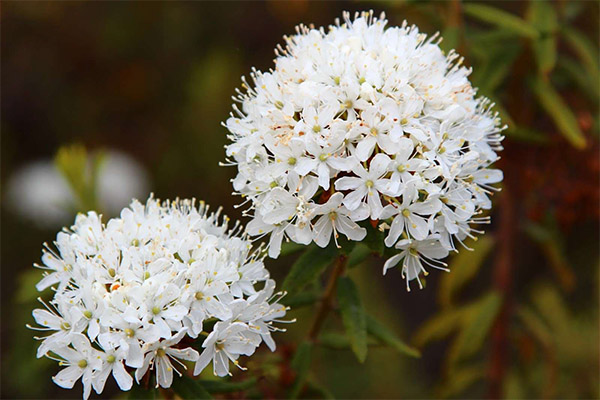
The use of marsh rosemary is strictly prohibited in any form in the following cases:
- If the woman is pregnant or breastfeeding. This can be explained by the fact that in the Ledum there are components that provoke severe bleeding, which can lead to the loss of a child at any time.
- If a person suffers from low blood pressure, severe allergic reactions, diseases such as pancreatitis and hepatitis.
- In any form, children under 16 years old.
It is recommended to take into account the exact dosage, which is prescribed in the instructions, if the drug is purchased in a pharmacy. Self-treatment should be handled extremely carefully, but it is better to consult a doctor who can prescribe the necessary dosage.
Preparations and cosmetic products based on rosemary have a number of side effects:
- dizziness and nausea;
- allergic reactions;
- manifestation of hallucinations;
- increased irritability, which is associated with a disorder of the nervous system.
If any side effects have been noticed, you must immediately cancel the drug and go to the hospital.
Marsh ledum, with a wide range of its application in human life, is a very popular plant. In addition, it is very affordable for almost every person in any corner of the world. If you don’t even have the opportunity to collect fresh rosemary yourself, you can always buy it in a pharmacy in any form at an affordable price. Ledum not only helps against many diseases, but also strengthens the human immune system quite well. Therefore, its use takes place at a preventive level. For example, you can add decoction from the branches of rosemary to tea.
An evergreen plant can become an indispensable tool both in maintaining human health and in everyday life. With all this, the main thing is to remember about the poisonous substance in Ledum. It is better to consult a doctor, beautician or other knowledgeable person about the use of marsh ledum.
«Important: all information on the site is provided exclusively in fact-finding purposes. Before applying any recommendations, consult with a profile specialist. Neither the editors nor the authors are liable for any possible harm caused materials. "


